Hedera helix
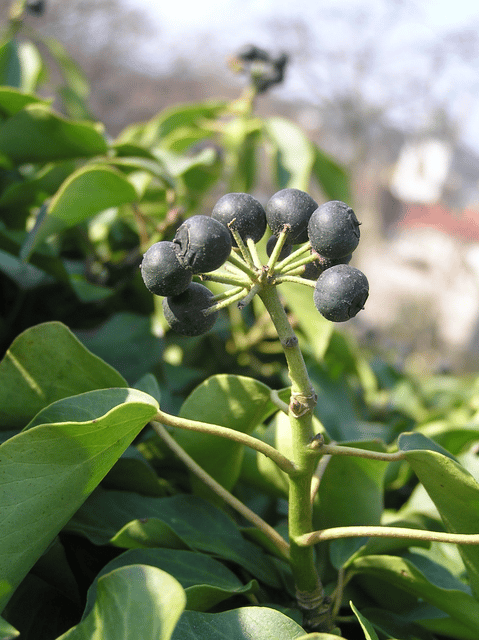
Hedera helix

| Hedera helix | |
|---|---|
| Adult leaves and fruit | |
| Scientific classification | |
| Kingdom: | Plantae |
| Clade: | Angiosperms |
| Clade: | Eudicots |
| Clade: | Asterids |
| Order: | Apiales |
| Family: | Araliaceae |
| Genus: | Hedera |
| Species: | H. helix |
| Binomial name | |
| Hedera helix | |
Hedera helix, the common ivy, English ivy, European ivy, or just ivy, is a species of flowering plant in the family Araliaceae, native to most of Europe and western Asia. A rampant, clinging evergreen vine, it is a familiar sight in gardens, waste spaces, on walls, tree trunks and in wild areas across its native habitat.
| Hedera helix | |
|---|---|
| Adult leaves and fruit | |
| Scientific classification | |
| Kingdom: | Plantae |
| Clade: | Angiosperms |
| Clade: | Eudicots |
| Clade: | Asterids |
| Order: | Apiales |
| Family: | Araliaceae |
| Genus: | Hedera |
| Species: | H. helix |
| Binomial name | |
| Hedera helix | |
Etymology
Hedera is the generic term for ivy. The specific epithet helix derives from Ancient Greek "twist, turn" (see: Helix), and from the Latin helicem, "spiral-shaped," first used around 1600.[1][2]
Synonyms
Description
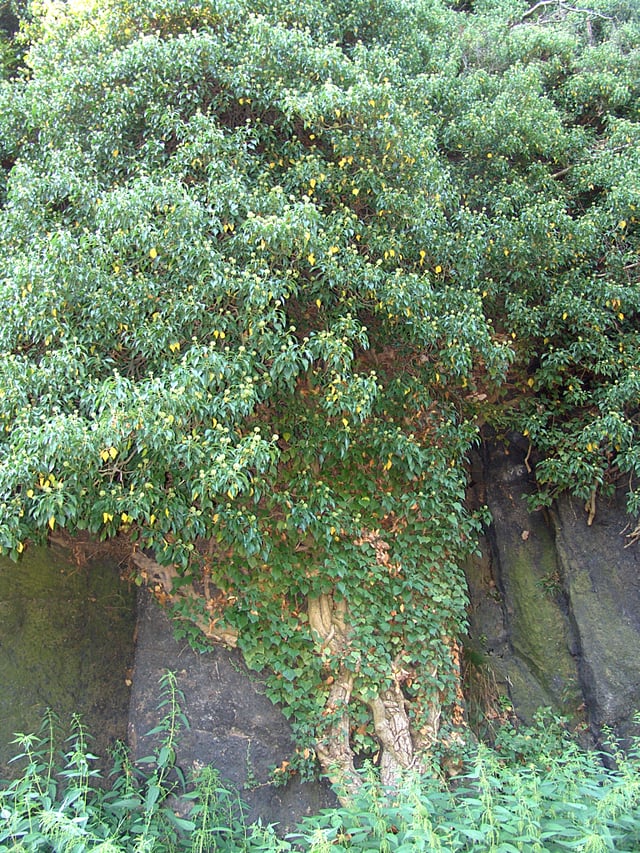
Ivy growing on a granite crag, Czech Republic.
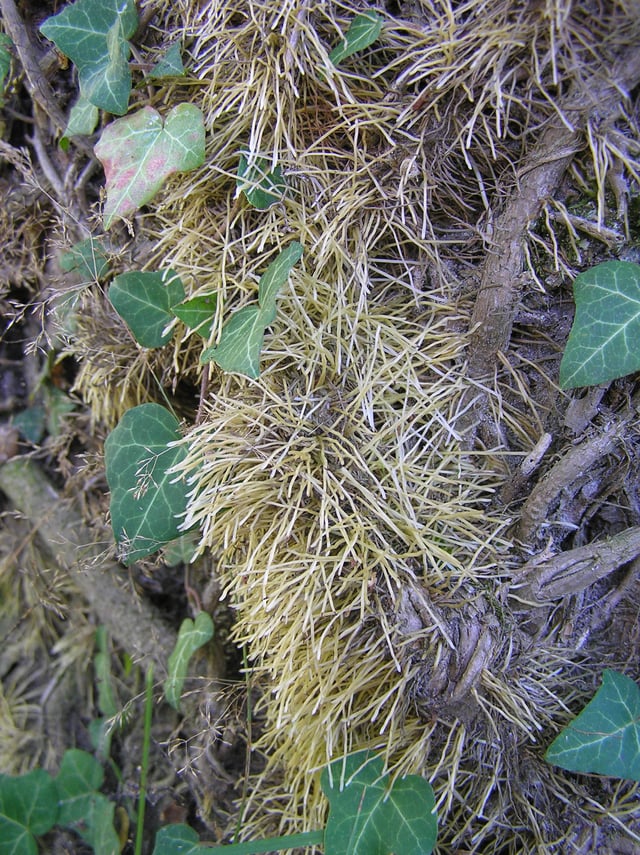
Stems showing the rootlets used to cling to walls and tree trunks.
Hedera helix is an evergreen climbing plant, growing to 20–30 m (66–98 ft) high where suitable surfaces (trees, cliffs, walls) are available, and also growing as groundcover where no vertical surfaces occur. It climbs by means of aerial rootlets with matted pads which cling strongly to the substrate. The ability to climb on surfaces varies with the plants variety and other factors: Hedera helix prefers non-reflective, darker and rough surfaces with near-neutral pH. It generally thrives in a wide range of soil pH with 6.5 being ideal, prefers moist, shady locations and avoids exposure to direct sunlight, the latter promoting drying out in winter.[5]
The leaves are alternate, 50–100 mm (2–4 in) long, with a 15–20 mm (0.6–0.8 in) petiole; they are of two types, with palmately five-lobed juvenile leaves on creeping and climbing stems, and unlobed cordate adult leaves on fertile flowering stems exposed to full sun, usually high in the crowns of trees or the top of rock faces.
The flowers are produced from late summer until late autumn, individually small, in 3-to-5 cm-diameter (1.2-to-2.0 in) umbels, greenish-yellow, and very rich in nectar, an important late autumn food source for bees and other insects.
Subspecies
The three subspecies are:[7][10]
H. h. helix - central, northern and western Europe, plants without rhizomes, purple-black ripe fruit,
H. h. poetarum Nyman (syn. Hedera chrysocarpa Walsh) - southeast Europe and southwest Asia (Italy, Balkans, Turkey), plants without rhizomes, orange-yellow ripe fruit,
H. h. rhizomatifera McAllister - southeast Spain, plants rhizomatous, purple-black ripe fruit.
The closely related species Hedera canariensis and Hedera hibernica are also often treated as subspecies of H. helix,[9][11] though they differ in chromosome number so do not hybridise readily.[8] H. helix can be best distinguished by the shape and colour of its leaf trichomes, usually smaller and slightly more deeply lobed leaves and somewhat less vigorous growth, though identification is often not easy.[9][12]
Range
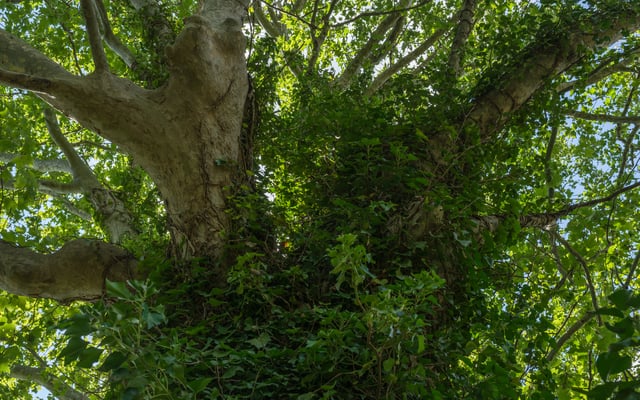
Common ivy clinging on a London plane tree in Agde.
It ranges from Ireland northeast to southern Scandinavia, south to Portugal, and east to Ukraine and Iran and northern Turkey.
Cultivation and uses
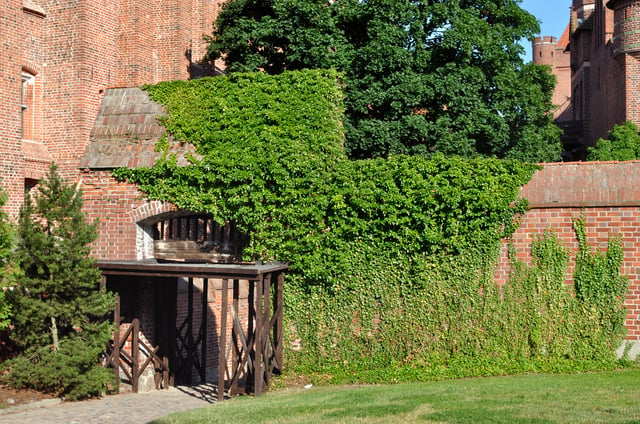
Ivy-covered entrance to Malbork Castle.
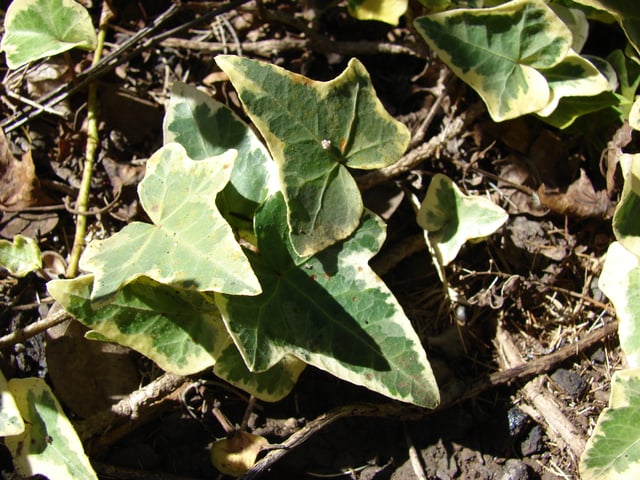
Variegated leaves at Enchanting Floral Gardens of Kula, Maui.
Ivy is widely cultivated as an ornamental plant. Within its native range, the species is greatly valued for attracting wildlife. The flowers are visited by over 70 species of nectar-feeding insects, and the berries eaten by at least 16 species of birds. The foliage provides dense evergreen shelter, and is also browsed by deer.[7][15]
In Europe, it is frequently planted to cover walls[16] and the government recommends growing it on buildings for its ability to cool the interior in summer, while providing insulation in winter, as well as protecting the covered building from soil moisture, temperature fluctuations and direct exposure to heavy weather.[17] Further uses include weed suppression in plantings, beautifying unsightly facades and providing additional green by growing on tree trunks.
However, ivy can be problematic. It is a fast-growing, self-clinging climber that is capable of causing damage to brickwork, guttering, etc., and hiding potentially serious structural faults, as well as harbouring unwelcome pests. Careful planning and placement are essential.[18]
Cultivars
Over 30 cultivars have been selected for such traits as yellow, white, variegated (e.g., 'Glacier'), and/or deeply lobed leaves (e.g. 'Sagittifolia'), purple stems, and slow, dwarfed growth.[19]
The following cultivars have gained the Royal Horticultural Society's Award of Garden Merit:[20]
Ethnomedical uses
Ivy extracts are part of current cough medicines.[35] In the past, the leaves and berries were taken orally as an expectorant to treat cough and bronchitis.[36] In 1597, the British herbalist John Gerard recommended water infused with ivy leaves as a wash for sore or watering eyes.[37] The leaves can cause severe contact dermatitis in some people.[38][39] People who have this allergy (strictly a type IV hypersensitivity) are also likely to react to carrots and other members of the Apiaceae as they contain the same allergen, falcarinol.
Invasive species
Like other exotic species, ivy has predominantly been spread to areas by human action. H. helix is labeled as an invasive species in many parts of the United States, and its sale or import is banned in the state of Oregon.[40]
Having disappeared during the glaciation, ivy is believed to have been spread back across the continent by birds once the continent warmed up again.[41] With a great capacity for adaptation, ivy will grow wherever development conditions and habitat similar to that of its European origins exist, occurring as opportunistic species across a wide distribution with close vicariant relatives and few species, indicating recent speciation.
Australia
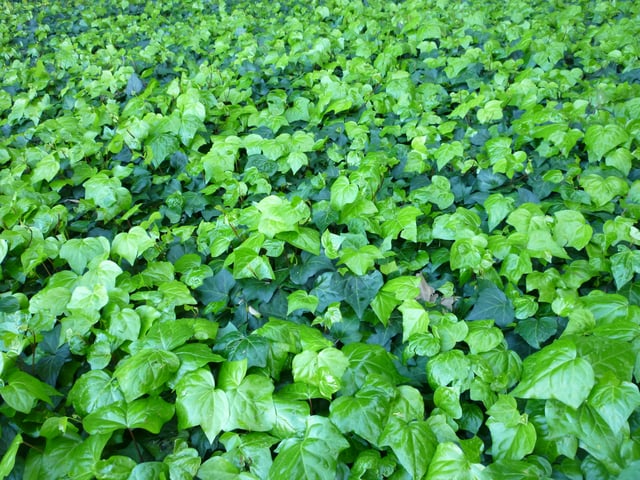
Hedera in Hyde Park, Sydney used decoratively as underplanting
It is considered a noxious weed across southern, especially south-eastern, Australia and local councils provide free information and limited services for removal. In some councils it is illegal to sell the plant. It is a weed in the Australian state of Victoria.[42]
New Zealand
H. helix has been listed as an "environmental weed" by the Department of Conservation since 1990.[43]
United States
In the United States, H. helix is considered weedy or invasive in a number of regions and is on the official noxious weed lists in Oregon and Washington.[44] Like other invasive vines such as kudzu, H. helix can grow to choke out other plants and create "ivy deserts". State- and county-sponsored efforts are encouraging the destruction of ivy in forests of the Pacific Northwest and the Southern United States.[45][46] Its sale or import is banned in Oregon.[47] Ivy can easily escape from cultivated gardens and invade nearby parks, forests and other natural areas.
Control and eradication
Ivy should not be planted or encouraged in areas where it is invasive. Where it is established, it is very difficult to control or eradicate. In the absence of active and ongoing measures to control its growth, it tends to crowd out all other plants, including shrubs and trees.
Damage to trees
Ivy can climb into the canopy of young or small trees in such density that the trees fall over from the weight,[46] a problem that does not normally occur in its native range.[7] In its mature form, dense ivy can destroy habitat for native wildlife and creates large sections of solid ivy where no other plants can develop.[46]
Use as building facade green
As with any self-climbing facade green, some care is required to make best use of the positive effects: Ivy covering the walls of an old building is a familiar and often attractive sight. It has insulating as well as weather protection benefits, dries the soil and prevents wet walls, but can be problematic if not managed correctly.
Ivy, and especially European ivy (H. helix) grows vigorously and clings by means of fibrous roots, which develop along the entire length of the stems. These are difficult to remove, leaving an unsightly "footprint" on walls, and possibly resulting in expensive resurfacing work. Additionally, ivy can quickly invade gutters and roofspaces, lifting tiles and causing blockages. It also harbors mice and other creatures. The plants have to be cut off at the base, and the stumps dug out or killed to prevent regrowth.[48]
Therefore, if a green facade is desired, this decision has to be made consciously, since later removal would be tedious.
Mechanism of attachment
Hedera helix is able to climb relatively smooth vertical surfaces, creating a strong, long lasting adhesion with a force of around 300 nN.[49] This is accomplished through a complex method of attachment starting as adventitious roots growing along the stem make contact with the surface and extend root hairs that range from 20-400 μm in length. These tiny hairs grow into any small crevices available, secrete glue-like nanoparticles, and lignify. As they dry out, the hairs shrink and curl, effectively pulling the root closer to the surface.[50] The glue-like substance is a nano composite adhesive that consists of uniform spherical nanoparticles 50-80 nm in diameter in a liquid polymer matrix. Chemical analyses of the nanoparticles detected only trace amounts of metals, once thought to be responsible for their high strength, indicating that they are largely organic. Recent work has shown that the nanoparticles are likely composed in large part of arabinogalactan proteins (AGPs), which exist in other plant adhesives as well.[51][52] The matrix portion of the composite is made of pectic polysaccharides. Calcium ions present in the matrix induce interactions between carboxyl groups of these components, causing a cross linking that hardens the adhesive.[51]